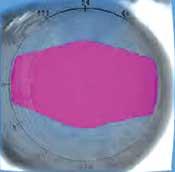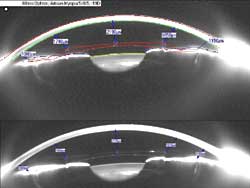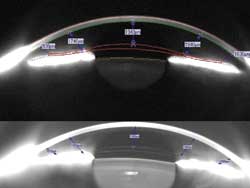Software simulates postop phakic IOL position
A study showed minimal differences between simulated and actual lens positions and indicates improved patient selection.
|
|
In an effort to improve the safety of phakic IOL positioning, researchers have developed imaging software that can preoperatively simulate the placement of the lenses. Testing showed good correlation between the simulated and actual position of the lens, according to one ophthalmologist.
Mana Tehrani, MD, of Johannes Gutenberg-University in Mainz, Germany, said this software could help refractive surgeons identify patients who may be at risk of postoperative complications.
“Long-term complications such as progressive endothelial cell loss, pigment dispersion or induction of cataract are still a concern,” Dr. Tehrani said.
In cooperation with Oculus, the imaging device manufacturer, Dr. Tehrani and H. Burkhard Dick, MD, developed the software.
Dr. Tehrani demonstrated the effectiveness of the new module at the 2006 European Society of Cataract and Refractive Surgeons meeting in London with results from a study of patients who underwent implant simulation before surgery.
|
Images: Tehrani M |
Simulation predicts placement
The study included 44 eyes of 23 patients undergoing phakic IOL implantation. The group consisted of 12 women and 11 men. The average patient age was 41 years.
According to Dr. Tehrani, four IOL types were used in the study to determine the range of the software’s accuracy. Seventeen eyes were implanted with a foldable IOL with a 6-mm optic and 8.5-mm length, 13 eyes were implanted with a rigid, myopic IOL with a 6-mm optic and 8.5-mm length, eight eyes were implanted with a rigid myopic lens with a 5-mm optic and 8.5-mm length, and six eyes were implanted with a rigid hyperopic IOL with a 5-mm optic and 8.5-mm length.
Mean IOL power was –8.7 D, ranging from –22.0 D to 11.0 D.
All patients underwent preop simulation and postop examination to determine the lens placement.
Comparisons of simulated measurements to the actual postop distances between the lens and vulnerable tissues showed little difference, Dr. Tehrani said.
“This study confirms the accurate preoperative simulation of postoperative phakic IOL position,” Dr. Tehrani said. “It is an effective tool to improve preop patient selection, precise preoperative exclusion of poor candidates and … the surgical plan in terms of IOL position and choice of implant.”
Software function
The software incorporates the functions of the Pentacam imaging system and includes a comprehensive database of available lenses that can be selected for simulation, according to an article published in the January issue of the Journal of Cataract and Refractive Surgery.
Outlines of the simulated lens are incorporated into all Scheimpflug images, including any shape distortions caused by optical refraction. The distances between the phakic IOL and ocular structures are calculated three-dimensionally from each surface point of the lens and are presented as color maps showing a top view of the implant and as minimum space values.
The phakic IOL can then be aligned in the color maps by dragging and dropping in any direction, according to the article.
“It’s easy. It doesn’t have to be the surgeon himself who does the Scheimpflug measurements,” Dr. Tehrani told Ocular Surgery News in a telephone interview.
However, there are a few factors beyond the user’s control, according to the journal article. Due to lens enclavation, the phakic IOL simulation is sometimes slightly higher than where it is actually located.
“It’s technically not possible to predict with every surgeon’s technique how much iris stroma he will enclavate and how the actual position will be after surgery,” Dr. Tehrani said during the telephone interview. “It’s not a significant difference at all, but this is something that you should know.”
|
|
|
Potential aging simulation
A version of the software that can simulate changes in the phakic IOL’s position during aging, up to the age of 80, is being developed, Dr. Tehrani said.
This new module is based on the theory that the anterior chamber depth decreases about 18 µm to 20 µm per year, she said, adding that studies are being conducted to determine if this is indeed the case.
“To do a really precise aging simulation, it is mandatory to do a prospective study where we have patients coming to us every year, and we are doing our anterior chamber measurements to see if this is really a value that we can rely on,” she said.
Dr. Tehrani and her colleagues said they also want to reflect the increasing popularity of toric IOLs with a toric database in the software.
“This is the only exception on the current version, but we will include it in the future,” she told Ocular Surgery News.
For more information:
- Mana Tehrani, MD, can be reached at Johannes Gutenberg-University, Department of Ophthalmology, Langenbeckstr. 1, 55131 Mainz, Germany; +49-6131-177085; fax: +49-6131-175566; e-mail: mtehrani@hotmail.de. She was involved in the development of the software and may receive a royalty agreement.
- Oculus Optikgeräte GmbH, maker of Pentacam HR, can be reached at Münchholzhäuser Str. 29, D-35582 Wetzlar, Germany; +49-0-641-2005-0; fax: +49-0-641-2005-255; Web site: www.oculus.de.
Reference:
- Tehrani M, Schaefer M, et al. Preoperative simulation of postoperative iris-fixated phakic intraocular lens position and simulation of aging using high-resolution Scheimpflug imaging. J Cataract Refract Surg. 2007;33:11-14.
- Jared Schultz is an OSN Staff Writer who covers all aspects of ophthalmology. He focuses geographically on Europe and the Asia-Pacific region.




